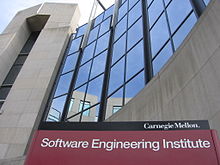The Capability Maturity Model (CMM) is a development model created in 1986 after a study of data collected from organizations that contracted with the U.S. Department of Defense, who funded the research. The term "maturity" relates to the degree of formality and optimization of processes, from ad hoc practices, to formally defined steps, to managed result metrics, to active optimization of the processes.

Carnegie Mellon University (CMU) is a private research university in Pittsburgh, Pennsylvania. The institution was originally established in 1900 by Andrew Carnegie as the Carnegie Technical Schools. In 1912, it became the Carnegie Institute of Technology and began granting four-year degrees. In 1967, it became the current-day Carnegie Mellon University through its merger with the Mellon Institute of Industrial Research, founded in 1913 by Andrew Mellon and Richard B. Mellon and formerly a part of the University of Pittsburgh.
Watts S. Humphrey was an American pioneer in software engineering who was called the "father of software quality."
The Personal Software Process (PSP) is a structured software development process that is designed to help software engineers better understand and improve their performance by bringing discipline to the way they develop software and tracking their predicted and actual development of the code. It clearly shows developers how to manage the quality of their products, how to make a sound plan, and how to make commitments. It also offers them the data to justify their plans. They can evaluate their work and suggest improvement direction by analyzing and reviewing development time, defects, and size data. The PSP was created by Watts Humphrey to apply the underlying principles of the Software Engineering Institute's (SEI) Capability Maturity Model (CMM) to the software development practices of a single developer. It claims to give software engineers the process skills necessary to work on a team software process (TSP) team.
Capability Maturity Model Integration (CMMI) is a process level improvement training and appraisal program. Administered by the CMMI Institute, a subsidiary of ISACA, it was developed at Carnegie Mellon University (CMU). It is required by many U.S. Government contracts, especially in software development. CMU claims CMMI can be used to guide process improvement across a project, division, or an entire organization. CMMI defines the following maturity levels for processes: Initial, Managed, Defined, Quantitatively Managed, and Optimizing. Version 2.0 was published in 2018. CMMI is registered in the U.S. Patent and Trademark Office by CMU.
Quality management ensures that an organization, product or service consistently functions well. It has four main components: quality planning, quality assurance, quality control and quality improvement. Quality management is focused not only on product and service quality, but also on the means to achieve it. Quality management, therefore, uses quality assurance and control of processes as well as products to achieve more consistent quality. Quality control is also part of quality management. What a customer wants and is willing to pay for it, determines quality. It is a written or unwritten commitment to a known or unknown consumer in the market. Quality can be defined as how well the product performs its intended function.

Carnegie Mellon Silicon Valley is a degree-granting branch campus of Carnegie Mellon University located in the heart of Silicon Valley in Mountain View, California. It was established in 2002 at the NASA Ames Research Center in Moffett Field.
Richard Turner is a distinguished service professor in the School of Systems and Enterprises of Stevens Institute of Technology in Hoboken, New Jersey.
Software assurance (SwA) is defined as "the level of confidence that software is free from vulnerabilities, either intentionally designed into the software or accidentally inserted at any time during its lifecycle, and that the software functions in the intended manner."

The CERT Coordination Center (CERT/CC) is the coordination center of the computer emergency response team (CERT) for the Software Engineering Institute (SEI), a non-profit United States federally funded research and development center. The CERT/CC researches software bugs that impact software and internet security, publishes research and information on its findings, and works with business and government to improve security of software and the internet as a whole.

Carnegie Mellon University in Australia is the Australian campus of Carnegie Mellon University's H. John Heinz III College established in 2006 in the city centre of Adelaide, South Australia.

Robert C. Seacord is an American computer security specialist and writer. He is the author of books on computer security, legacy system modernization, and component-based software engineering.
The Information Networking Institute (INI) was established by Carnegie Mellon in 1989 as the nation's first research and education center devoted to information networking.
Ultra-large-scale system (ULSS) is a term used in fields including Computer Science, Software Engineering and Systems Engineering to refer to software intensive systems with unprecedented amounts of hardware, lines of source code, numbers of users, and volumes of data. The scale of these systems gives rise to many problems: they will be developed and used by many stakeholders across multiple organizations, often with conflicting purposes and needs; they will be constructed from heterogeneous parts with complex dependencies and emergent properties; they will be continuously evolving; and software, hardware and human failures will be the norm, not the exception. The term 'ultra-large-scale system' was introduced by Northrop and others to describe challenges facing the United States Department of Defense. The term has subsequently been used to discuss challenges in many areas, including the computerization of financial markets. The term 'ultra-large-scale system' (ULSS) is sometimes used interchangeably with the term 'large-scale complex IT system' (LSCITS). These two terms were introduced at similar times to describe similar problems, the former being coined in the USA and the latter in the UK.

Roger Redmond Bate was a brigadier general, Rhodes Scholar, professor, and scientist who has held a variety of positions with the Air Force, Texas Instruments, and the Software Engineering Institute at Carnegie Mellon University.
An insider threat is a perceived threat to an organization that comes from people within the organization, such as employees, former employees, contractors or business associates, who have inside information concerning the organization's security practices, data and computer systems. The threat may involve fraud, the theft of confidential or commercially valuable information, the theft of intellectual property, or the sabotage of computer systems.
Bill Curtis is a software engineer best known for leading the development of the Capability Maturity Model and the People CMM in the Software Engineering Institute at Carnegie Mellon University, and for championing the spread of software process improvement and software measurement globally. In 2007 he was elected a Fellow of the Institute of Electrical and Electronics Engineers (IEEE) for his contributions to software process improvement and measurement. He was named to the 2022 class of ACM Fellows, "for contributions to software process, software measurement, and human factors in software engineering".
The Cyber Resilience Review (CRR) is an assessment method developed by the United States Department of Homeland Security (DHS). It is a voluntary examination of operational resilience and cyber security practices offered at no cost by DHS to the operators of critical infrastructure and state, local, tribal, and territorial governments. The CRR has a service-oriented approach, meaning that one of the foundational principles of the CRR is that an organization deploys its assets to support specific operational missions. The CRR is offered in a facilitated workshop format and as a self-assessment package. The workshop version of the CRR is led by a DHS facilitator at a critical infrastructure facility. The workshop typically takes 6–8 hours to complete and draws on a cross section of personnel from the critical infrastructure organization. All information collected in a facilitated CRR is protected from disclosure by the Protected Critical Infrastructure Information Act of 2002. This information cannot be disclosed through a Freedom of Information Act request, used in civil litigation, or be used for regulatory purposes. The CRR Self-Assessment Package allows an organization to conduct an assessment without the need for direct DHS assistance. It is available for download from the DHS Critical Infrastructure Cyber Community Voluntary Program website. The package includes an automated data answer capture and report generation tool, a facilitation guide, comprehensive explanation of each question, and a crosswalk of CRR practices to the criteria of the National Institute of Standards and Technology (NIST) Cybersecurity Framework. The questions asked in the CRR and the resulting report are the same in both versions of the assessment. DHS partnered with the CERT Division of the Software Engineering Institute at Carnegie Mellon University to design and deploy the CRR. The goals and practices found in the assessment are derived from the CERT Resilience Management Model (CERT-RMM) Version 1.0. The CRR was introduced in 2009 and received a significant revision in 2014.

Larry E. Druffel is an American engineer, Director Emeritus and visiting scientist at the Software Engineering Institute (SEI) at Carnegie Mellon University. He has published over 40 professional papers/reports and authored a textbook. He is best known for leadership in: (1) bringing engineering discipline and supporting technology to software design and development, and (2) addressing network and software security risks.

The External Dependencies Management Assessment is a voluntary, in-person, facilitated assessment created by the United States Department of Homeland Security. The EDM Assessment is intended for the owners and operators of critical infrastructure organizations in the United States. It measures and reports on the ability of the subject organization to manage external dependencies as they relate to the supply and operation of information and communications technology (ICT). This area of risk management is also sometimes called Third Party Risk Management or Supply Chain Risk Management.












